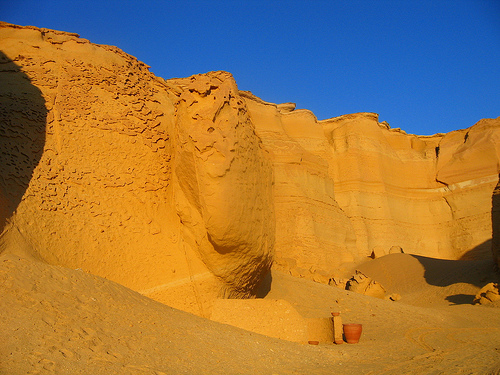 Wait, what? Whales in the desert? Fossils of earliest suborder of now extinct whale sheds new light on evolution.
Wait, what? Whales in the desert? Fossils of earliest suborder of now extinct whale sheds new light on evolution.
Even though human population expansion and over-exploitation of natural resources has accelerated the rate at which climatic change wreaks havoc, nature has always been in flux. Few things drive this concept home more concretely than a boat load of whale fossils in the desert. This is what was just reportedly found in Egypt.
British geologist Hugh J.L. Beadnell conducted a geological survey of Egypt in the early 1900s, discovering within the Western Desert of Egypt 150 km southwest of Cairo and 80 km west of Faiyum City, stashed amidst the sandstone, limestone and shale left behind 40 million years ago when the Tethys Sea slunk back towards the Mediterranean, the fossils of the earliest suborder of whales (links to PDF on the whales).
Vulnerable to curious visitors and furious winds, these tombs, these ancestral Archaeoceti tombs of the two modern suborders of cetaceans Mysticeti and Odontoceti received UNESCO World Heritage status in 2005.
The University of Michigan, which began conducting expeditions of what is now known as “whale valley” beginning in 1983, were the first to discover that whales used to have hind feet before they evolved into the slick serpentine creatures we now know them to be.
Most remarkable about this discovery, according to the International Union for the Conservation of Nature and Natural Resources (IUCN) is that these particular fossils – many unusually intact and representing different phases of development – demonstrate the whale’s departure from land and shallow coastal waters to full fledged ocean-going.
 The learning gleaned from this and a nearby site containing “the most complete record of Palaeogene mammals for all Africa… [including] two hominoid genera is critical to understanding the evolution of many mammal groups on the continent, particularly hominids,” the IUCN wrote.
The learning gleaned from this and a nearby site containing “the most complete record of Palaeogene mammals for all Africa… [including] two hominoid genera is critical to understanding the evolution of many mammal groups on the continent, particularly hominids,” the IUCN wrote.
Considering this rich archaeological prelude, the Egyptian State Information Service’s weekend claim that an Egyptian archaeological team has discovered yet more prehistoric whale skeletons in the same region came as a huge surprise. They report that among various tools and weapons, scientists discovered a fossilized whale embryo.
Surprise yes. But disinterest, no. Because Egyptians take their tourist bait seriously, and because any such discovery leads to new understanding and maybe, if we’re lucky, more ecological preservation. These are early discovery days yet, but we will certainly keep you informed.
:: via Egyptian State Information Service
More green news from Egypt:
Egypt’s Bahariya Oasis Trampled By Tourism
Kids in Cairo Survive on Crusts and Crumbs
Egypt Eco-Group HEPCA Reports Red Sea Spill is Capped, Beaches Cleaned
[top image via klvinci; lower image via walid.hassanein]




can we find fossils in Indonesia???
Thanks Cassandra – we will look into it; are you an archaeologist? Any insight you can provide would be welcome. Feel free to email me personally. Thanks.
The whales wer first discovered in the 1800s by the German scientist Schwinfurth. They were later excavated by a team from New York’s Museum of Natural History in the first decade of the 20th century. See the book The WEstern Desert of Egypt.